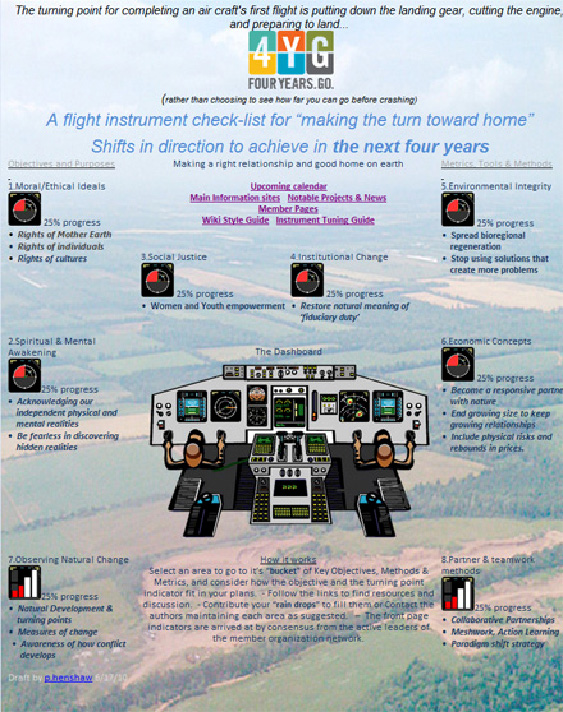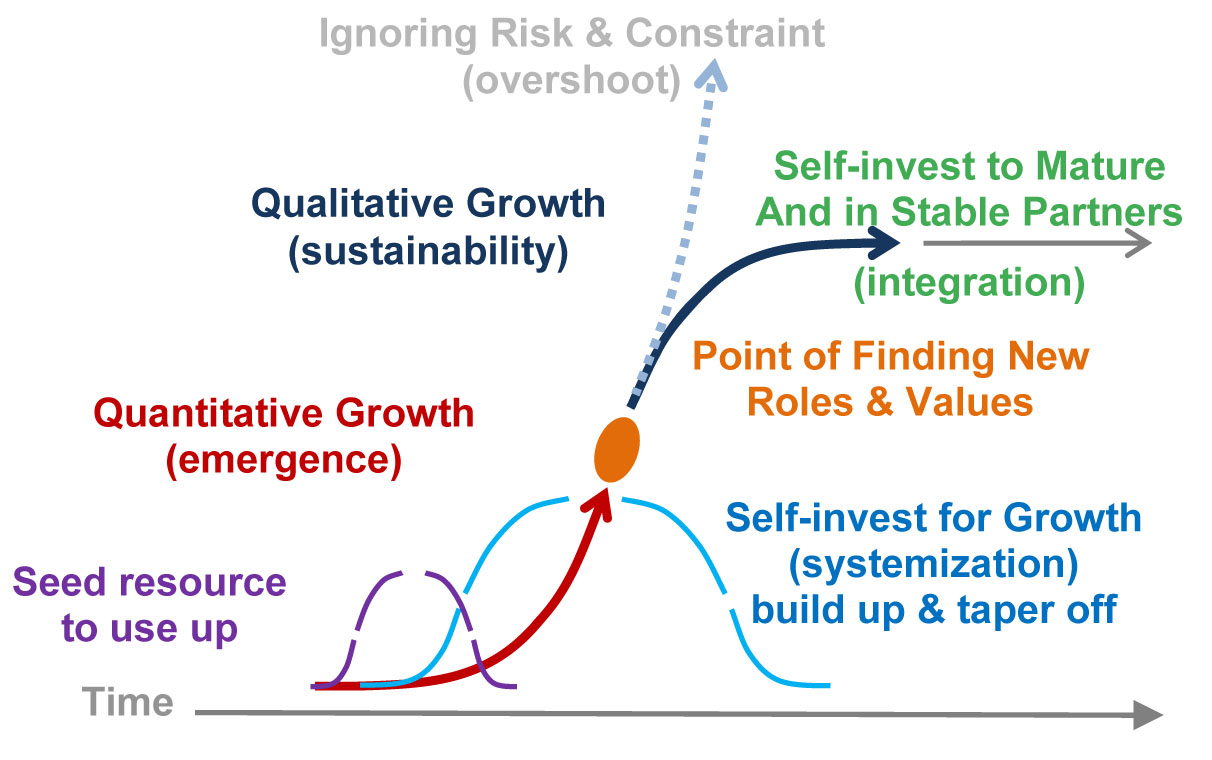Designing a “dashboard” of “Outcomes and Metrics” for guiding worldwide efforts for our pulling back from the brink of of environmental catastrophe, to begin healing our relationship with the earth, is of some considerable importance, and a fascinating task. Below is one email exchange and links.
Applying the transformational vision of Four Years Go a work group developed a draft plan and resources for a comprehensive transformational approach you can find linked to our draft 4YG Dashboard (image below). We wanted to use a wiki to develop key indicators of essential changes in direction, of material, political and spiritual transformation, within 4 years.
Our starting points had been other models, like the Ursula Project’s metrics of sustainability and the European Commission’s MDG Goals Dashboard. We also looked at different PES (Payment for Environmental Services) approaches, and found them objectionable, and CSR (comprehensive sustainability reporting) models, but found them nebulous for our purpose, of defining concrete achievement goals. We ended up having difficulty deciding what to include, not understanding each other’s definitions, and with other 4YG work groups getting more attention. We seem to have accomplished a lot in terms of the conceptual design, though.

Mark,
You’re right, there still is a need for a more ethical ‘dashboard’ than the approach the financial community seems to be taking with “Payment for Environmental Services” (PES) instruments, and “Sustainable Performance Indicators” seemingly for monetizing all of nature for trading in new commodities markets, like repackaged mortgages are!
The Ursula Project model does show considerable effort in constructing a holistic measurement system. Their metrics are interesting too. They seem to rely on consensus value judgments, though, and not to identify physical boundaries or thresholds.
key indicators of essential changes in direction, of material, political and spiritual transformation, within 4 years.
Relying on value judgments could also allow the popular mistakes that got us into our present fix to slip right through again. The problem is not the intent, but with relying on our own unreliable social values to represent nature’s values.
Take the difference between “sustainable growth” (big applause!) and “sustainable transformation” (ah… what’s that?). The former is familiar maximizing benefits as we try to be sensitive about incurring undesirable costs.
The problem is that’s the underlying motive of capitalism too, finding every profitable way to change nature in our own image. Regardless of how carefully it is done I think it leads to much bigger mistakes than are contemplated.
I certainly don’t reject human values, but see defining the needs of nature in terms of our values as a sign of bigger problems. The worst effect to my mind is how it represents our values as complete, and so hides our need to discover new values ourselves.
In searching nature for the values that successful growth systems exemplify, you find there’s a point of changing values as they transition from explosive growth toward becoming established. They graduate from one form of organizational change to a higher one.
The real puzzle of course is, How? Hazel Henderson and Fritjof Capra also have this natural succession from quantitative to qualitative growth at the center of some of their proposals now.
Learning from natural growth systems is like biomimicry, studying successful examples of systems that internally reorganize at the end of their initial growth and then progress toward becoming secure in their environments. You find suggestions in them for how we might do the same thing.
In part what you find is a change from efficiently expanding control to assuring freedoms, a switch between two different kinds of responsiveness. It can help to study almost any kind of growth system as starting with ‘viral events’, looking for how they work and what becomes of them. They have internal energy transferring parts that respond to each other and so allow distributed systems to emerge and behave as a whole.
So, I think measures tracking that physical change in form are needed as part of any “dashboard” for planet earth.
Phil Henshaw ¸¸¸¸.·´ ¯ `·.¸¸¸¸
~~~~~~~~~~~~~~~~~~~~~~~~~~~~~~~~~~~
__________
Then Dick Hogan suggested that a better well known philosophy to center on might be found in Deep Ecology approach.
Dick,
That’s a good connection. The core philosophy of Deep Ecology fits closely with what I find implied by how autonomous natural systems develop, need to be recognized as individuals and allowed to work on their own. To me Deep Ecology only falls short in lacking practical applications. I think that lack of practical applications comes partly from blending in the wrong “new physics” and its beautiful but intangible philosophy. What’s impractical is the lack of references to the working parts of nature that people can relate to.
That “new physics” was an extrapolation from strange world of Quantum Mechanics. It described nature as essentially statistical and offered no way to discuss change as involving building processes, such as growth, or any other macroscopic process either. My form of “new physics” points clearly and directly to the individual building processes by which the organisms and cultures of nature develop and change, and to how they need to work on their own. So I think a “new physics” more like mine would provide a much more direct way to apply a philosophy that recognizes the inherent worth of things in nature.
The stumbling block seems to be that the kind of organization nature uses for making individual things is written in their own original languages, as it of course logically would be. So to study them means finding some of their sentences first before having a way to discover what some of their words mean…. ![]()
phil
This seems to be the key to our making a go of the earth, learning how lasting change begins with things “breaking out” in an explosion of creativity, to then change course and find how to fit in.
There’s no doubt in my mind that to change the behavior of a society organized around people hoarding money and multiplying their control over everything else on earth, when people who see the problem reach a critical mass, it will become necessary for them to stop doing business with people who insist on continuing to hoard their disproportionate earnings and not spend them. At that point, things will happen very quickly.
_________
2/3/11 – In response to a question about contacting Al Gore, perhaps, about bringing together other a team of NGO’s to work on building a real Sustainability Dashboard for the Earth I replied the following, to which Walt replied “Cool”:
Walt,
Well, there are lots of possible purposes and measures one might include, so it is demanding to think about. Others included on that invitation have spent a good deal of time struggling with it, building different concepts of what is measurable and important to show connections between. I’d like to see what their interests are before adding them to a cc list for discussion, unless you want to copy your reply to this to others you want to share it with.
I just ask what measures and control indicators might be most useful for human “pilots” of the earth. I guess in terms of driving a car that’s “do you have the gas, see the situation and the road, and are able to get the cooperation of the parts to control the vehicle”. Did you look at my 1st dashboard model concept that I made for a 4YG group? A dashboard needs at least a combination of 1) clear functional and cultural purposes and progress indicators for 2) strains on the parts of the economy & ecology, 3) their limits of stability, ability to adapt, and needs for time or guidance and support from others, and 4) signs of approaching natural limits, like physical bankruptcy thresholds, and rates of responding to them.
So what to select for a dashboard is then a combination of functional systems ecology measures linked to human aspirations and experiences, so everyone can begin to intuitively connect the cultural values to the functional necessities, connecting those physical steering dimensions of the problem. In that email I was pointing partly to the lack of good functional indicators. A lot of organizing seems to presume that nature will respond as we want if people just have the right moral and social purposes in mind. That’s not true at all, of course. Prime examples are how the effort to prevent climate change came to include sustaining the ever escalating demands of the financial system, and so to avoid responding to natural limits rather than accommodate them gracefully.
My starting point for selecting functional indicators is my little glyph (¸¸.•´ ¯ `•.¸¸), used as a generic map of developmental phases for energy using systems, their sequence from take-off” to “landing”, you could say. That’s a univesal experience for energy using systems, that I identified in connecting my observatons with theoretical physics research, and found useful as a guide to learning about them. Our current growth challenge is to determine what to do with the first main turning point ( ¸¸.?´ ¯ ). Our growth system needs to change its way of changing, switching from multiplying our control of our environment as a resource to the opposite way of interacting with it, integrating with it as a partner free to act on its own. So indicators of progress or barriers to reorienting our world that way are part of what I put on the dashboard.
You might think of a long list of progress or barrier indicators, perhaps. It takes both an idea of an achievable threshold and an indicator of approaching it. To me, one indicator of reorienting from expanding our control of nature as a resource to taking nature as a partner would be just getting the idea of that as a critical whole system turning point discussed in the SD community, as a functional performance indicator to guage other things with.
Seem OK?

